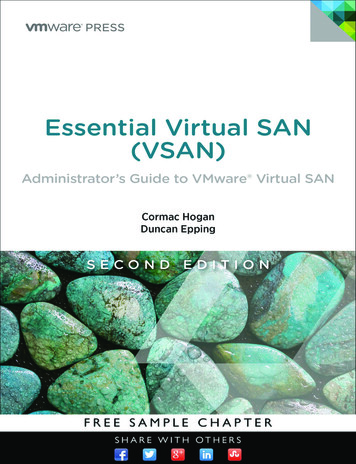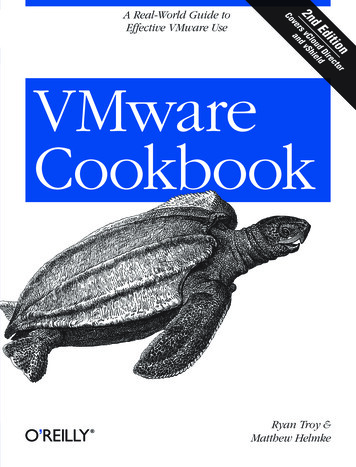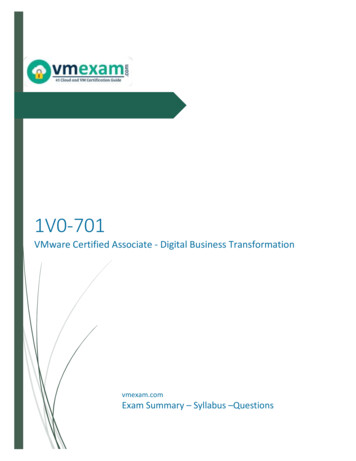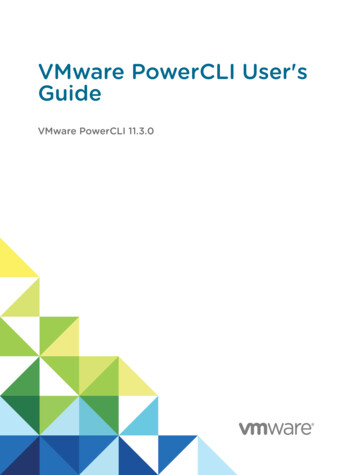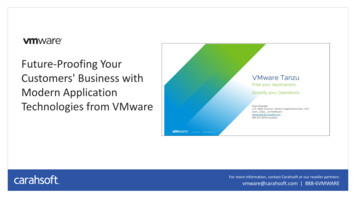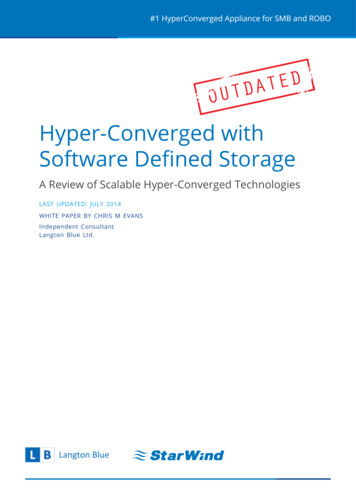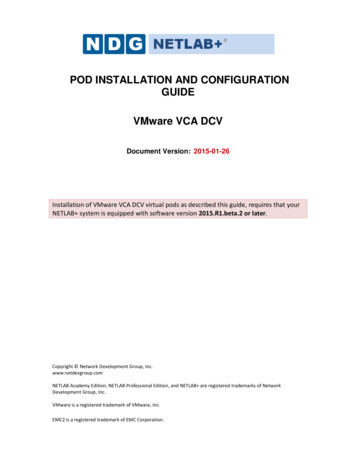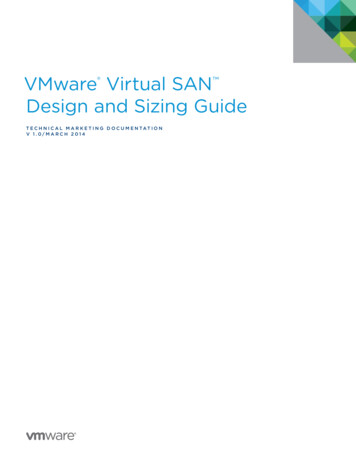
Transcription
VMware Virtual SAN Design and Sizing GuideT E C H N I C A L M A R K E T I N G D O C U M E N TAT I O NV 1 .0/MARCH 2014
VMware Virtual SAN Design and Sizing GuideTable of ContentsIntroduction . . . . . . . . . . . . . . . . . . . . . . . . . . . . . . . . . . . . . . . . . . . . . . . . . . . . . . . . . . . . . . . . . . . 31.1 VMware Virtual SAN. . . . . . . . . . . . . . . . . . . . . . . . . . . . . . . . . . . . . . . . . . . . . . . . . . . . . . . 31.2 Virtual SAN Datastore Characteristics and Sizing. . . . . . . . . . . . . . . . . . . . . . . . . . . . . 31.2.1 Disk Groups . . . . . . . . . . . . . . . . . . . . . . . . . . . . . . . . . . . . . . . . . . . . . . . . . . . . . . . . . . 31.2.2 Virtual SAN Datastore. . . . . . . . . . . . . . . . . . . . . . . . . . . . . . . . . . . . . . . . . . . . . . . . . 41.2.3 Objects and Components. . . . . . . . . . . . . . . . . . . . . . . . . . . . . . . . . . . . . . . . . . . . . . 41.3 Virtual SAN Datastore Sizing Considerations. . . . . . . . . . . . . . . . . . . . . . . . . . . . . . . . . 51.3.1 Number of Failures to Tolerate . . . . . . . . . . . . . . . . . . . . . . . . . . . . . . . . . . . . . . . . . 51.4 Design Considerations. . . . . . . . . . . . . . . . . . . . . . . . . . . . . . . . . . . . . . . . . . . . . . . . . . . . . 61.4.1 Multiple Disk Groups. . . . . . . . . . . . . . . . . . . . . . . . . . . . . . . . . . . . . . . . . . . . . . . . . . . 61.4.2 Flash Capacity Sizing. . . . . . . . . . . . . . . . . . . . . . . . . . . . . . . . . . . . . . . . . . . . . . . . . . 61.4.3 Memory and CPU . . . . . . . . . . . . . . . . . . . . . . . . . . . . . . . . . . . . . . . . . . . . . . . . . . . . . 71.4.4 Network. . . . . . . . . . . . . . . . . . . . . . . . . . . . . . . . . . . . . . . . . . . . . . . . . . . . . . . . . . . . . . 71.4.5 Installation Media . . . . . . . . . . . . . . . . . . . . . . . . . . . . . . . . . . . . . . . . . . . . . . . . . . . . . 81.5 Size-Calculating Formulas. . . . . . . . . . . . . . . . . . . . . . . . . . . . . . . . . . . . . . . . . . . . . . . . . . 91.5.1 Cluster Capacity . . . . . . . . . . . . . . . . . . . . . . . . . . . . . . . . . . . . . . . . . . . . . . . . . . . . . . 91.5.2 Objects . . . . . . . . . . . . . . . . . . . . . . . . . . . . . . . . . . . . . . . . . . . . . . . . . . . . . . . . . . . . . . 91.5.3 Components. . . . . . . . . . . . . . . . . . . . . . . . . . . . . . . . . . . . . . . . . . . . . . . . . . . . . . . . . . 91.5.4 Swap. . . . . . . . . . . . . . . . . . . . . . . . . . . . . . . . . . . . . . . . . . . . . . . . . . . . . . . . . . . . . . . . 101.5.5 Usable Capacity. . . . . . . . . . . . . . . . . . . . . . . . . . . . . . . . . . . . . . . . . . . . . . . . . . . . . . 10Conclusion . . . . . . . . . . . . . . . . . . . . . . . . . . . . . . . . . . . . . . . . . . . . . . . . . . . . . . . . . . . . . . . . . . . 11Acknowledgments. . . . . . . . . . . . . . . . . . . . . . . . . . . . . . . . . . . . . . . . . . . . . . . . . . . . . . . . . . . . . 11About the Author . . . . . . . . . . . . . . . . . . . . . . . . . . . . . . . . . . . . . . . . . . . . . . . . . . . . . . . . . . . . . 11TECH N I C AL WH ITE PAPE R / 2
VMware Virtual SAN Design and Sizing GuideIntroduction1.1VMware Virtual SANVMware Virtual SAN is a new hypervisor-converged, software-defined storage platform that is fully integratedwith VMware vSphere . Virtual SAN aggregates locally attached disks of hosts that are members of a vSpherecluster, to create a distributed shared storage solution. Virtual SAN enables the rapid provisioning of storagewithin VMware vCenter as part of virtual machine creation and deployment operations.Virtual SAN is a hybrid disk system that leverages both flash-based devices, to provide optimal performance,and magnetic disks, to provide capacity and persistent data storage. This delivers enterprise performance and aresilient storage platform.The distributed datastore of Virtual SAN is an object-store file system that leverages the vSphere Storage PolicyBased Management (SPBM) framework to deliver application-centric storage services and capabilities that arecentrally managed through vSphere virtual machine storage policies.This document focuses on the definitions, sizing guidelines, and characteristics of the Virtual SANdistributed datastore.1.2Virtual SAN Datastore Characteristics and Sizing1.2.1 Disk GroupsDisk groups by definition are management constructs created by the combination of locally attachedflash-based and magnetic disk devices. The creation of a disk group requires the assignment of a singleflash-based device—SAS, SATA, or PCIe SSD—and one or more magnetic disks—SAS or SATA HDD. Disk groupscompose the distributed flash tier and storage capacity of the Virtual SAN datastore.The Virtual SAN distributed flash layer optimizes virtual machine and application performance by providing readcaching and write buffering in front of all magnetic disks. Capacity is divided into two segments: 70 percent forread cache and 30 percent as write buffer.All the disk groups are formatted with a modified on-disk file system, VMware vSphere VMFS-L. They are thenmounted onto the object store file system datastore as a single datastore. VMFS-L formatting consumes a totalof 750MB of capacity per disk.A R T I FAC T SMINIMUMSMAXIMUMSDisk groupsOne per hostFive per hostFlash devices:SAS, SATA, PCIe SSDOne per disk groupOne per disk groupMagnetic disk devicesOne HDD per disk groupSeven HDDs per disk groupDisk formatting overhead750MB per HDD750MB per HDDTable 1. Disk Groups, Devices, and OverheadTECH N I C AL WH ITE PAPE R / 3
VMware Virtual SAN Design and Sizing Guide1.2.2Virtual SAN DatastoreThe Virtual SAN distributed datastore capacity is determined by aggregating the disk groups situated acrossmultiple hosts that are members of a vSphere cluster and by the size of the magnetic disks. Disk groups consistof a combination of flash-based devices and magnetic disks pooled together, but only the usable capacity of themagnetic disks counts toward the total capacity of the Virtual SAN datastore. The capacity of the flash-baseddevices is specifically dedicated to the caching layer of Virtual SAN.1.2.3Objects and ComponentsObjectsIn Virtual SAN, an object is defined based on an individual storage block device that is compatible with SCSIsemantics. Conceptually, an object can also be thought of as “volumes,” the term used in Amazon EC2 andOpenStack. In Virtual SAN, the only supported objects are virtual machine files such as VMDKs.In Virtual SAN, each object that resides on the Virtual SAN datastore comprises multiple components, which aredistributed across hosts that are members of a vSphere cluster. Objects are assigned storage performance andavailability services requirements through the virtual machine storage policies feature. Based on applyingdefined performance and availability requirements to ones specific to each object, components are distributedthroughout a vSphere cluster onto physical disk devices.OBJECT T YPESDEFINITIONSVM homeLocation where all virtual machine configuration filesreside: .vmx, log files, and othersSwapUnique storage object created only when virtualmachines are powered onVMDKVirtual machine disk filesDelta/SnapshotUnique storage object created only for virtual machinesnapshotsTable 2. Virtual SAN Objects and DefinitionsComponentsIn Virtual SAN, objects comprise components that are distributed across hosts in a vSphere cluster. Thesecomponents are stored in distinctive combinations of disk groups within the Virtual SAN distributed datastore.Components are transparently assigned caching and buffering capacity from flash-based devices, with theirdata “at rest” on the magnetic disks. Virtual SAN 5.5 currently supports a maximum of 3,000 componentsper host.Objects greater than 255GB in capacity automatically are divided into multiple components. In addition, if thenumber-of-disk-stripes-per-object capability is increased beyond the default value of one, each stripe is aseparate component. For every component created in Virtual SAN, an additional 2MB of disk capacity isconsumed for metadata.Witness components—those that contain only object metadata—are part of every storage object. A witnessserves as a tiebreaker, to avoid split-brain behavior when availability decisions are made in the Virtual SANcluster. Each Virtual SAN witness component also consumes 2MB of capacity.TECH N I C AL WH ITE PAPE R / 4
VMware Virtual SAN Design and Sizing Guide1.3Virtual SAN Datastore Sizing ConsiderationsThe Virtual SAN storage solution is designed to deliver capacity, availability, and performance capabilities tovirtual machines. Users must understand how these storage capabilities affect consumption of storage capacityin Virtual SAN. The number-of-failures-to-tolerate capability has the biggest impact.1.3.1 Number of Failures to TolerateThe number-of-failures-to-tolerate policy setting is an availability capability that can be applied to all virtualmachines or individual VMDKs. This policy plays an important role when planning and sizing storage capacity forVirtual SAN. Based on the availability requirements of a virtual machine, the setting defined in a virtual machinestorage policy can lead to the consumption of as many as four times the capacity of the virtual machine orindividual disks.For example, if the number of failures to tolerate is set to 1, two replica mirror copies of the virtual machine orindividual VMDKs are created across the cluster. If the number is set to 2, three mirror copies are created; if thenumber is set to 3, four copies are created. Figures 1 through 4 illustrate the layout of the virtual machineobjects, based on the number of failures to tolerate.Figure 1. Number of Failures to Tolerate 1 2 Full Copies of Data 1 WitnessFigure 2. Number of Failures to Tolerate 2 3 Full Copies of Data 2 WitnessesTECH N I C AL WH ITE PAPE R / 5
VMware Virtual SAN Design and Sizing GuideFigure 3. Number of Failures to Tolerate 3 4 Full Copies of Data 3 WitnessesNOTE: Virtual SAN implements a system default policy with a number of failures to tolerate equal to 1 on allvirtual machine objects deployed on the Virtual SAN shared datastore.1.4Design Considerations1.4.1 Multiple Disk GroupsIn Virtual SAN, disk group configurations are limited to a maximum of one flash-based device per disk group. Ifhosts that participate in a Virtual SAN cluster contain more than one flash-based device, multiple disk groups arecreated to utilize the additional devices.When creating disk groups, users can then decide on the ratio of flash-based devices to magnetic diskswhenever performance is a requirement. The higher the ratio of flash-based–device capacity to magnetic-diskcapacity, the greater the size of the cache layer.Another reason to consider a configuration with multiple disk groups is to have the ability to define and reducestorage failure domains. If a flash-based device fails, all the magnetic disks within that particular disk groupbecome unusable and the total storage capacity provided by the affected disk group becomes unavailable tothe cluster. When working with multiple disk groups, the failure domain is limited to only the magnetic disks inthat particular disk group.The failure of a disk group can impact a large number of virtual machines if the cluster does not have enoughstorage capacity to provide for the virtual machines affected by the failure. In the worst-case scenario, restoringall affected virtual machines can take a long time.NOTE: When all flash-based devices and magnetic disks are inaccessible, a host failure renders all disk groupsunavailable and unusable.1.4.2 Flash Capacity SizingIn Virtual SAN, 30 percent of each flash-based device is used as a write-back buffer. Each write first goes ontothe flash-based device; it is persisted in as many flash-based devices as there are replicas for the correspondingobjects—VMDKs, for example. This rule is strictly enforced to ensure the required availability of data.Virtual SAN uses 70 percent of each flash-based device as read cache. A block is never placed in the read cacheof more than one flash-based device. Unlike with the write cache, Virtual SAN maintains the same percentage ofthe flash-based device as read cache for an object, irrespective of the number of replicas. In other words,increasing the availability of an object does not increase the usage of the read cache of the flash-based device.TECH N I C AL WH ITE PAPE R / 6
VMware Virtual SAN Design and Sizing GuideThe general recommendation for sizing flash capacity for Virtual SAN is to use 10 percent of the anticipatedconsumed storage capacity before the number of failures to tolerate is considered. For example, a user plans toprovision 1,000 virtual machines, each with 100GB of logical address space, thin provisioned. However, theyanticipate that over time, the consumed storage capacity per virtual machine will be an average of 20GB.Table 3 shows a simple sizing scenario based on the general recommendation for flash capacity.MEASUREMENT REQUIREMENTSVA L U E SProjected virtual machine space usage20GBProjected number of virtual machines1,000Total projected space consumption20GB x 1,000 20,000GB 20TBTarget flash capacity percentage10 percentTotal flash capacity required20TB x .10 2TBTable 3. Flash Capacity SizingSo, in aggregate, the anticipated consumed storage, before replication, is 1,000 x 20GB 20TB. If the virtualmachine’s availability factor is defined to support number of failures to tolerate equals 1 (FTT 1), thisconfiguration results in creating two replicas for each virtual machine—that is, a little more than 40TB ofconsumed capacity, including replicated data. However, the flash sizing for this case is 10 percent x 20TB 2TBof aggregate flash capacity in the cluster where the virtual machines are provisioned.The optimal value of the target flash capacity percentage is based upon actual workload characteristics, such asthe size of the working set of the data on disk. Ten percent is a general guideline to use as the initial basis forfurther refinement.1.4.3 Memory and CPUThe memory requirements for Virtual SAN are defined based on the number of disk groups and disks that aremanaged by a hypervisor. Virtual SAN currently supports a maximum of five disk groups per host and amaximum of eight disk devices per disk group: one flash-based device and seven magnetic disks.As long as vSphere hosts have memory configurations of more than 32GB of RAM, they can support themaximum disk group and disk configuration supported in Virtual SAN. Because of the memory overheadrequirement in Virtual SAN, consider having memory configurations greater than 32GB per host to support thefull storage capacity and scalability capabilities of Virtual SAN.Virtual SAN is designed to introduce no more than 10 percent of CPU overhead per host. Consider this fact inVirtual SAN implementations with high consolidation ratios and CPU-intensive application requirements.1.4.4 NetworkVirtual SAN provides support for both vSphere standard switch and VMware vSphere Distributed Switch , witheither 1GbE or 10GbE network uplinks. Although both vSphere switch types and network speeds work withVirtual SAN, VMware recommends the use of the vSphere Distributed Switch with 10GbE network uplinks.These recommendations are made because of the possible replication and synchronization activities thatVirtual SAN might impose on the network based on the number of virtual machines hosted in the system andthe number of active operations.Virtual SAN network activities potentially can saturate and overwhelm the entire 1GbE network speed capacity,particularly during rebuild and synchronization operations.TECH N I C AL WH ITE PAPE R / 7
VMware Virtual SAN Design and Sizing GuideWhenever possible, consider the use of the vSphere Distributed Switch in combination with VMware vSphereNetwork I/O Control to share the 10GbE interfaces. Separate the various traffic types—management,VMware vSphere vMotion , virtual machine, Virtual SAN—onto different VLANs and use shares as a quality ofservice (QoS) mechanism to sustain the level of performance expected during possible contention scenarios.Figure 4. vSphere Distributed Switch with vSphere Network I/O Control ConfigurationFor the best security and performance, use the same approach recommended for the vSphere vMotion networkand isolate Virtual SAN network traffic to its own layer 2 network segment. Virtual SAN requires that IP multicastbe enabled on the layer 2 physical network segment utilized for Virtual SAN intracluster communication. Layer 2multicast traffic can be limited to specific port groups by using IGMP snooping. VMware does not recommendimplementing multicast flooding across all ports as a best practice. Virtual SAN does not require layer 3multicast for any of its network communication requirements.Network adapter teamed configuration is supported in Virtual SAN as an availability and redundancy measure.Virtual SAN does not leverage teaming of network adapters for the purpose of bandwidth aggregation. For apredictable level of performance, VMware recommends the use of multiple network adapters in active–passivemode with explicit failover order whenever using a route based on the originating virtual port ID load-balancingmechanism. Active–active configurations are recommended when using physical network adapters connectingto Link Aggregation Control Protocol (LACP) port channels and using the following load-balancing algorithms: Route based on IP hash Route based on physical network adapter load1.4.5 Installation MediaConsider the following recommendations when deploying VMware ESXi for use with Virtual SAN: Use SD, USB, or hard disk devices as the installation media whenever ESXi hosts are configured with as muchas 512GB memory. Use a separate magnetic disk or solid-state disk as the installation device whenever ESXi hosts are configuredwith more than 512GB memory.TECH N I C AL WH ITE PAPE R / 8
VMware Virtual SAN Design and Sizing Guide1.5Size-Calculating FormulasSizing for Virtual SAN can be approached in several ways. In this section, we will start with a given hardwareconfiguration; after taking into account certain policy settings, we will then ascertain how much actual space isavailable for virtual machines. This is useful when determining how much usable capacity is available in apreconfigured Virtual SAN cluster.The following scenario lists the assumptions that will be used as the basis for all of the sizing calculations inthis section: Number of hosts per cluster (Hst) 8 Number of disk groups (DskGrp) 5 Number of disks per disk group (DskPerDskGrp) 7 Size of disks (SzHDD) 4,000GB Number of failures to tolerate (ftt) 1 Number of virtual machines (VMs) 800 Number of disks per virtual machine (NumOfVMDK) 1 Memory per virtual machine (vmSwp) 10GB1.5.1 Cluster CapacityVirtual SAN raw storage capacity calculations can be performed using the following formula: Formula: Hst x NumDskGrpPerHst x NumDskPerDskGrp x SzHDD y Example: 8 x 5 x 7 x 4,000GB 1,120,000GB 1,120TB1.5.2 ObjectsThe number of objects is based on the virtual machine files, which include virtual machine home, virtual machineswap file, VMDKs, and snapshots. Formula: VMs x [VMnamespace vmSwap NumOfVMDK] y Example: 800 x [1 1 1] 2,400 ObjectsNOTE: Snapshots count as individual objects in Virtual SAN. In this scenario, however, virtual machines were notidentified as using snapshots; therefore, snapshots are calculated as part of the equation.1.5.3 ComponentsThe number of objects per virtual machine, in addition to their performance and availability requirements,dictates the number of components that will be created. As mentioned earlier, Virtual SAN currently supports amaximum of 3,000 components per host. The following formula can be used to calculate the number ofcomponents per virtual machine. It accounts for the replicas and witnesses created based on the Failures toTolerate setting. The resulting number of components is nominally split across all the hosts in the cluster. Formula: Object x [ftt x 2 1] y Example: 2,400 x (1 x 2 1) 7,200 components average 900 components per hostNOTE: If the number-of-disk-stripes-per-object capability is increased beyond the default value of 1, each stripeis a separate component. In this scenario, however, the number of disk stripes is kept at the default value of 1, soit does not affect the calculation.TECH N I C AL WH ITE PAPE R / 9
VMware Virtual SAN Design and Sizing Guide1.5.4 SwapA certain amount of raw capacity will be consumed by virtual machine swap space. Virtual SAN always storesswap space with two replicas, regardless of the Failures to Tolerate setting: Formula: ClusterCapacity – (VMs x vmSwp x 2) Example: 1,120,000GB – (800 x 10GB x 2) 1,120,000 – 16,000 1,104,000GB Disk Capacity1.5.5 Usable CapacityVirtual SAN usable capacity is the amount of capacity that can be used to store the VMDK files of all virtualmachines. It is determined by subtracting the Virtual SAN overhead from the disk capacity and then dividing theremaining amount by the number of failures to tolerate plus 1: Formula: (DiskCapacity – DskGrp x DskPerDskGrp x Hst x VSANoverhead )/(ftt 1) Example: (1,104,000GB – 280GB)/(ftt 1) 1,103,720GB/(2) 551,860GB Usable CapacityNOTE: As a general guideline, 1GB of storage capacity per disk will be calculated as the combination ofVirtual SAN components and VMFS metadata overheard (VSANoverhead).So of approximately 1,120TB of raw capacity, users can create VMDKs that in total consume as many as 551TB.The remainder is consumed primarily by replicas created for availability and virtual machine swap space. In thiscase, for 800 virtual machines with a single virtual disk, each VMDK can be as large as 689GB.In practice, no more than 80 percent of this capacity should be allocated to virtual machines, to allow for otherfactors such as snapshots and working space. In addition, the total number of components, which depends on avariety of factors, must remain within the limit of 3,000 per host. In this case, we have approximately 900components per host, but an increase in the number of disks per virtual machine, stripes per object, orsnapshots will contribute to a higher component count.The following graphs illustrate the results of these calculations. They show the raw capacity split into three majorcontributions. The virtual machine swap consumption is in blue, the space used for replicas is in orange, and thespace available to allocate for virtual disks is in green. The entire overhead consumed by Virtual SAN—VMFSmetadata and component metadata—is too small to be seen in the graph and can be considered negligible formost calculations. The lower graph also shows in red the capacity that is lost after the failure of a single host inthis eight-host cluster.VM Swap FilesReplicasAvailable Spacefailed HostsVSAN MetadataAll Hosts ActiveAfter 1 Host 080000090000010000001120000Disk Space Usage Distribution (in GB)Figure 5. Sizing Scenario ResultsTECH N I C AL WH ITE PAPE R / 1 0
VMware Virtual SAN Design and Sizing GuideConclusionVMware Virtual SAN is a hypervisor-converged platform that delivers a shared datastore by combining computeand storage resources of VMware vSphere hosts in a vSphere cluster while providing a much simpler storagemanagement experience for the user. It is a storage solution designed by VMware to make software-definedstorage a reality for its customers. Because certain factors must be taken into account when sizing anddesigning a Virtual SAN cluster, this paper has presented much of what must be considered to successfullydeploy a Virtual SAN configuration.AcknowledgmentsI would like to thank Jorge Guerra, Christian Dickmann, and Christos Karamanolis of VMware R&D, whose deepknowledge and understanding of Virtual SAN was leveraged throughout this paper. I would also like to thankCharu Chaubal, group manager of the Storage and Availability Technical Marketing team; Kiran Madnani, seniorproduct line manager of storage technologies products; and Wade Holmes, senior technical marketing architectwithin the Storage and Availability Technical Marketing team, for their contributions and for reviewing this paper.About the AuthorRawlinson Rivera is a senior architect in the Cloud Infrastructure Technical Marketing group at VMware. His focusis on storage virtualization, software-defined storage technologies, and integration aspects of VMware productsand solutions with the OpenStack framework. Previously he was an architect in the VMware Cloud Infrastructureand Management Professional Services organization, focused on vSphere and cloud enterprise architectures forVMware Fortune 100 and 500 customers.Rawlinson is among the first VMware Certified Design Experts (VCDX#86) and is the author of multiple booksbased on VMware and other technologies.Follow Rawlinson’s blogs: http://blogs.vmware.com/vsphere/storage http://www.punchingclouds.comFollow Rawlinson on Twitter: @PunchingCloudsTECH N I C AL WH ITE PAPE R / 11
VMware, Inc. 3401 Hillview Avenue Palo Alto CA 94304 USA Tel 877-486-9273 Fax 650-427-5001 www.vmware.comCopyright 2014 VMware, Inc. All rights reserved. This product is protected by U.S. and international copyright and intellectual property laws. VMware products are covered by one or more patents listedat http://www.vmware.com/go/patents. VMware is a registered trademark or trademark of VMware, Inc. in the United States and/or other jurisdictions. All other marks and names mentioned herein may betrademarks of their respective companies. Item No: VMW-TMD-VSAN-Dsgn-Szng-Guide-USLET-101Docsource: OIC - 14VM004.11
VMware Virtual SAN is a new hypervisor-converged, software-defined storage platform that is fully integrated with VMware vSphere . Virtual SAN aggregates locally attached disks of hosts that are members of a vSphere cluster, to create a distributed shared storage solution. Virtual SAN enables the rapid provisioning of storage


